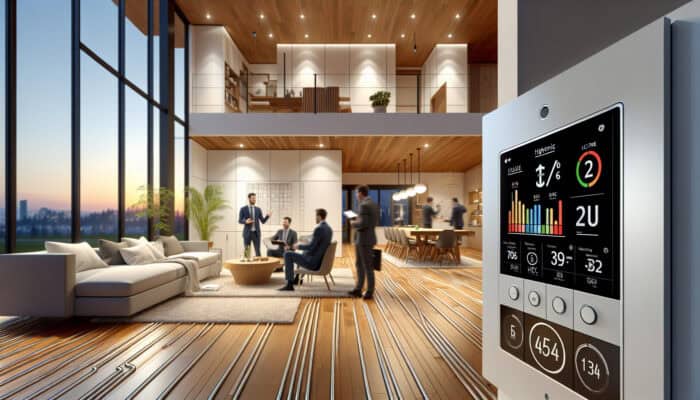Uncover the Remarkable Benefits of Hydronic Radiant Floor Heating for Your Living Space
Understanding the Cutting-Edge Technology Behind Hydronic Radiant Floor Heating

Hydronic radiant floor heating is an advanced method of home heating that employs warm water flowing through a network of tubes installed beneath your flooring. This innovative system ensures even heat distribution throughout your living areas, creating a cozy and inviting atmosphere without the drafts or cold spots commonly found in traditional heating systems. The essential components of a hydronic radiant floor heating system include:
- Boiler: Heats the water necessary for the system’s operation.
- Circulating Pump: Enables the movement of water through the tubing.
- Piping: Typically made from PEX, responsible for effectively transporting water beneath the floor.
- Thermostat: Controls the temperature to maintain optimal comfort levels.
- Insulation: Enhances system efficiency and directs heat upward, thus improving warmth retention.
This state-of-the-art approach allows homeowners to maintain a tailored and comfortable ambient temperature in every room, making it a top choice for those who value both efficiency and comfort.
Why Investing in Hydronic Heating Systems is a Wise Choice for Your Home
Deciding to install a hydronic heating system in your home can provide a wealth of compelling advantages compared to conventional heating solutions. Let’s explore the three most significant benefits:
- Energy Efficiency: Hydronic systems are engineered to utilize less energy, operating at lower water temperatures while still delivering effective heating performance.
- Superior Comfort: With warmth evenly distributed across the floor, these systems eliminate cold spots and drafts, creating a more pleasant living environment.
- Silent Operation: Unlike forced air systems that can be noisy, hydronic systems operate quietly, enhancing the tranquility of your home.
These advantages not only improve your comfort but also lead to lower energy bills, making hydronic systems a smart option for homeowners in Vancouver looking to optimise their heating solutions.
How Hydronic Systems Achieve Maximum Efficiency in Heating
The functionality of hydronic radiant floor heating is built upon a simple yet highly effective principle. A boiler heats water, which is then circulated through a network of tubes embedded within the floor. As the warm water moves through these pipes, heat radiates upward, warming both the floor and the air in the room uniformly. This method provides an optimal heating experience, allowing warmth to rise naturally, thus eliminating the need for fans or blowers.
Moreover, the efficiency of this system is greatly improved by the installation of insulation beneath the flooring material, which directs heat upwards and prevents heat loss downwards. As a result, every room enjoys consistent temperatures, substantially enhancing overall comfort. Additionally, with a programmable thermostat, homeowners can customize their heating schedules, further maximizing energy efficiency.
Expert Insights into Hydronic Radiant Floor Heating Services Offered in Vancouver

Why Vancouver’s Climate is Ideal for Hydronic Heating Solutions
The climate of Vancouver is particularly well-suited for hydronic radiant floor heating systems. Characterized by a temperate oceanic climate with mild, wet winters, effective heating is crucial. Maintaining a comfortable indoor temperature during the colder months is essential for residents, and hydronic systems excel in providing warmth while avoiding the temperature fluctuations typically seen with forced-air heating solutions.
Additionally, many homes in Vancouver are architecturally designed to accommodate radiant heating, featuring open floor plans that facilitate effective heat distribution. Implementing hydronic systems within multifamily dwellings or high-efficiency homes aligns seamlessly with the city’s sustainability goals, making it an excellent option for both new builds and renovations. Furthermore, the lower emissions associated with hydronic systems contribute positively to Vancouver’s environmental initiatives.
Understanding the Comprehensive Installation Process and Best Practices for Hydronic Systems
The successful installation of a hydronic radiant floor heating system necessitates careful planning and execution to ensure optimal performance. Initially, it involves assessing the specific heating needs of the home, taking into account factors such as size, layout, and insulation quality. After this evaluation, the installation usually includes the following stages:
- Design: Create a customized system layout tailored to the unique requirements of the home.
- Preparation: Ensure the subfloor is clean and level to facilitate installation.
- Piping Installation: Position the PEX tubing according to the designed layout.
- Insulation: Install insulation boards to minimize heat loss during operation.
- Testing: Conduct a pressure test of the system to check for leaks before covering.
- Final Covering: Pour concrete or lay the flooring material over the tubing.
Numerous successful installations across Vancouver demonstrate the effectiveness of these systems, with many homeowners reporting significant improvements in comfort and energy savings following installation. Proper installation not only guarantees the system’s durability but also maximizes its efficiency, allowing homeowners to fully benefit from hydronic heating.
Essential Maintenance Practices to Ensure the Longevity of Hydronic Systems

To keep a hydronic radiant floor heating system running efficiently and to prolong its lifespan, it is crucial to adopt several key maintenance practices that homeowners in Vancouver should follow:
- Annual Inspections: Schedule a thorough examination of the system at least once a year to catch any potential issues early.
- Bleeding the System: Release trapped air from the pipes to ensure smooth water flow and effective heating.
- Monitoring Pressure Levels: Regularly check the system’s pressure gauge to confirm optimal performance.
- Boiler Checks: Ensure that the boiler is functioning efficiently and effectively.
- Filter Maintenance: Consistently clean or replace filters to maintain air quality and system efficiency.
By following these maintenance recommendations, homeowners can ensure their hydronic systems operate smoothly, providing consistent warmth while minimizing energy costs. Local HVAC professionals in Vancouver can also offer specialized maintenance services tailored specifically to hydronic systems.
Analyzing the Costs and Efficiency of Hydronic Radiant Floor Heating
What Are the Typical Costs Involved in Installing Hydronic Systems?
The initial investment for installing a hydronic radiant floor heating system can vary widely based on several factors, including the size of the home, the complexity of the installation, and the specific components selected. On average, homeowners in Vancouver can expect to spend between $6 and $15 per square foot for installation, influenced by these various considerations.
For example, smaller homes may incur costs on the lower end of this range, while larger residences with complex layouts or additional features like zoning systems could approach the higher end. Other factors include the type of flooring material, the quality of the boiler, and the overall design of the system. When budgeting for this installation, it is essential to consider not only the upfront costs but also the potential long-term savings associated with lower energy bills and increased comfort levels.
Exploring the Long-Term Energy Savings and Efficiency Benefits of Hydronic Systems
One of the most impressive benefits of hydronic radiant floor heating systems is their exceptional energy efficiency, which translates into substantial long-term savings for homeowners. Hydronic systems typically operate at lower water temperatures compared to traditional heating methods, resulting in reduced energy consumption. This efficiency directly leads to lower heating bills, particularly during Vancouver’s cold winter months.
Additionally, the ability to heat different areas of the home independently enables homeowners to heat only the spaces they occupy, further maximizing savings. Over time, investing in hydronic heating can yield up to a 30% reduction in heating bills compared to conventional systems, making it a smart long-term investment for homeowners.
How Do Hydronic Systems Compare in Cost to Other Heating Solutions?
When evaluating the financial implications of installing a hydronic radiant floor heating system, it is important to compare costs with alternative heating solutions, such as forced air or electric heating systems. While the initial installation costs for hydronic systems may be higher, the long-term savings and enhanced comfort they offer make them a competitive alternative.
For instance, forced-air systems often require more frequent maintenance and can result in uneven heating, leading to increased energy costs. In contrast, electric heating systems may have lower upfront costs but typically show less energy efficiency, especially in colder climates like Vancouver. By carefully assessing installation costs, energy efficiency, and potential savings, homeowners can make informed decisions that best suit their heating needs and financial circumstances.
What Homeowners Need to Know About Maintenance and Operational Costs
Understanding the ongoing expenses associated with maintaining and operating a hydronic radiant floor heating system is vital for homeowners. While initial installation costs may be significant, the long-term operational costs are generally lower than those of alternative heating systems. Major ongoing expenses include boiler maintenance, routine inspections, and minor repairs, which can typically be budgeted on an annual basis.
Moreover, energy consumption for hydronic systems tends to be lower than for traditional heating systems, resulting in reduced heating bills over time. Homeowners should also consider water usage; however, hydronic heating systems are engineered for efficiency, minimizing water waste. Overall, the operational costs of hydronic radiant floor heating systems are usually favorable compared to conventional heating solutions, underscoring their value as a long-term investment.
How System Design Influences Cost and Efficiency in Hydronic Heating
The design of a hydronic radiant floor heating system is a critical factor in determining both its initial cost and operational efficiency. A well-structured design not only optimizes heat distribution but also minimizes energy consumption. Elements such as tubing layout, flooring material choice, insulation levels, and the incorporation of smart thermostats can significantly affect system performance.
For instance, implementing a zoned system allows different areas of the home to be heated independently, enhancing comfort and increasing efficiency. Furthermore, selecting high-quality materials for piping and insulation can reduce heat loss, thereby improving overall system efficiency. Homeowners in Vancouver should collaborate with experienced professionals to design a system that meets their specific requirements while ensuring optimal cost-effectiveness and efficiency.
Exploring the Mechanics of Hydronic Radiant Floor Heating
Understanding the Principles of Radiant Heat Transfer in Hydronic Systems
The core principle of hydronic radiant floor heating is based on the concept of heat transfer through radiation rather than convection. Radiant heat directly warms objects and surfaces, creating a comfortable atmosphere without the drafts and noise that often accompany traditional heating systems. This method is particularly efficient, guaranteeing even heat distribution that eliminates the cold spots commonly experienced in forced-air systems.
The science behind this approach utilizes the natural characteristics of heat transfer, where warmth rises from the heated floor. Consequently, the temperature at floor level can be substantially lower than the air above while still providing equivalent comfort levels. This efficiency leads to reduced energy consumption, making radiant heating an environmentally friendly choice that aligns with sustainable living practices.
Identifying the Essential Components of a Hydronic Heating System
A hydronic radiant floor heating system consists of several critical components, each playing a vital role in its overall functionality. The primary elements include the boiler, which heats the water; a circulating pump that moves the heated water through the piping; and the tubing itself, usually made from cross-linked polyethylene (PEX). These tubes are installed within a concrete slab or beneath the flooring material to guarantee effective heat distribution.
Another key component is the thermostat, which regulates the system’s temperature, allowing for personalized comfort settings. Additionally, insulation is crucial for retaining heat within the system, maximizing efficiency and minimizing energy loss. Understanding the role of each component helps homeowners appreciate the sophistication and efficiency of hydronic radiant floor heating systems.
What Types of Hydronic Systems Can Homeowners Choose From?
There are several varieties of hydronic radiant floor heating systems available, each designed to meet specific needs and preferences. The most common types include:
- Wet Systems: These systems involve laying tubing in a concrete slab or beneath the floor, filled with water to provide heating.
- Dry Systems: These utilize thermal mass materials, such as gypsum panels, for heat transfer without the necessity of water.
- Mixing Systems: These combine warm water with lower temperature systems, allowing for added flexibility in heating various zones.
- Radiant Panel Systems: These systems incorporate panels into walls or ceilings, enhancing both aesthetic appeal and functionality.
Selecting the appropriate type of hydronic system depends on the specific requirements of the home and the homeowner’s preferences. Consulting local experts in Vancouver can assist in identifying the most suitable solution for your heating needs.
Designing and Aesthetically Integrating Hydronic Radiant Floor Heating into Your Home
Effectively Blending Hydronic Systems into Home Design
Incorporating hydronic radiant floor heating into your home design presents a unique chance to merge functionality with aesthetic appeal. Unlike traditional radiators or ductwork, hydronic heating can be discreetly installed beneath various flooring materials, including hardwood, tile, and carpet. This flexibility allows homeowners to maintain their design vision while enjoying efficient heating.
When planning the integration, consider factors such as tubing layout and the type of flooring material selected. For example, utilizing natural stone or tile can enhance thermal mass, improving the system’s efficiency and comfort levels. Collaborating with a designer experienced in hydronic systems ensures that the heating installation complements the overall aesthetic of the home, resulting in a cohesive living environment.
The Aesthetic Benefits of Radiant Flooring
Radiant flooring provides more than just warmth; it significantly enhances the aesthetic value of a home. With no visible heating units, homeowners can achieve a cleaner, more streamlined look in their interiors. This subtle heating method grants greater design freedom, allowing homeowners to choose furniture and decor without constraints imposed by traditional heat sources.
Furthermore, radiant floor heating offers consistent warmth that maintains comfort levels throughout the home, enriching the overall ambiance. The diverse array of flooring materials compatible with radiant systems, from elegant hardwood to contemporary tiles, enables homeowners to personalize their space while reaping the practical benefits of efficient heating. Ultimately, radiant flooring can elevate both the visual and emotional appeal of a home, creating a haven of comfort.
Customizing Hydronic Solutions for Unique Homes in Vancouver
Every residence in Vancouver is unique, and hydronic radiant floor heating systems can be tailored to meet individual preferences and requirements. Homeowners can choose from various tubing layouts, heating zones, and flooring materials to create a personalized heating solution. For instance, areas of the home that require different temperatures can be zoned with separate controls, allowing customized comfort levels in each space.
Customization extends to the type of boiler and control systems selected. Homeowners can opt for high-efficiency models that align with their sustainability goals, alongside smart home technology for remote monitoring and adjustments. These options not only enhance convenience but also promote energy savings, reinforcing the value of a customized hydronic heating system that caters to a home’s specific needs.
Dependable Strategies for Hydronic Radiant Floor Heating Services in Vancouver
Selecting the Right Service Provider for Your Heating Needs
Choosing a reliable service provider is paramount for the success of your hydronic radiant floor heating system. A trustworthy contractor can ensure proper installation and maintenance, maximizing system efficiency and longevity. When assessing potential providers in Vancouver, consider the following essential criteria:
- Experience: Look for a company with a proven track record in hydronic heating installations.
- Certifications: Confirm that they hold the necessary licenses and certifications to perform the work.
- Customer Reviews: Explore testimonials and feedback to gauge satisfaction levels.
- Warranty Options: Inquire about warranties covering both the installation and the equipment.
- After-Sales Service: Choose a provider that offers ongoing support and maintenance services.
By thoroughly vetting potential service providers, homeowners can ensure a successful installation and continuous support for their hydronic radiant floor heating system.
Key Considerations During the Installation Process of Hydronic Systems
When installing a hydronic radiant floor heating system, several critical factors must be considered to ensure optimal performance and efficiency. First, conducting a comprehensive assessment of the home’s heating requirements is essential. This analysis should take into account variables such as square footage, insulation quality, and any existing heating systems, which will inform the system’s design and layout.
Secondly, selecting the right components is crucial. Quality materials for piping, insulation, and the boiler can significantly influence the system’s efficiency and lifespan. Additionally, adequate insulation beneath the flooring is vital to prevent heat loss and ensure even heat distribution. Partnering with experienced professionals can help address these important considerations and guarantee a successful installation of a hydronic system.
Strategies for Enhancing the Efficiency of Hydronic Systems
To boost the efficiency of your hydronic radiant floor heating system, several strategies can be implemented. Firstly, consider adopting a zoned heating approach, which allows individual temperature control in different areas of the home. This method not only increases comfort but also reduces energy waste by heating only the occupied spaces.
Moreover, regular maintenance is crucial for ensuring optimal performance. This includes checking the boiler, bleeding the system to eliminate air pockets, and cleaning filters. Utilizing programmable thermostats can also help refine heating schedules, ensuring energy is not wasted when areas are unoccupied. By integrating these strategies, homeowners can fully benefit from their hydronic heating systems while minimizing energy costs.
Essential Maintenance Tips for Ensuring Longevity of Hydronic Systems
Regular maintenance is vital to guarantee the longevity of your hydronic radiant floor heating system. Local experts suggest conducting annual inspections to identify potential issues before they escalate. This includes assessing the boiler for efficiency, monitoring pressure levels, and ensuring proper water circulation through the pipes.
Homeowners should also proactively bleed the system to eliminate trapped air, facilitating smooth water circulation. Additionally, regularly cleaning or replacing filters is essential for maintaining air quality and system performance. By adhering to these maintenance guidelines, you can protect your investment and ensure that your hydronic heating system operates effectively for years to come.
How to Effectively Budget for Hydronic Radiant Floor Heating?
Budgeting effectively for a hydronic radiant floor heating system involves understanding both the initial costs and the ongoing expenses associated with the system. Homeowners should account for installation costs, which can vary based on factors such as the size of the home and the complexity of the system. It is crucial to obtain multiple quotes from reputable contractors to compare pricing and the services they provide.
In addition to upfront costs, it is important to consider long-term operational expenses, including energy costs, maintenance, and potential repairs. Hydronic systems typically offer lower operational costs compared to traditional heating methods, but homeowners should still allocate funds for regular maintenance and inspections to ensure optimal performance. By evaluating both initial and ongoing costs, homeowners can make informed financial decisions regarding their heating solutions.
Unique Advantages of Hydronic Radiant Floor Heating
Exploring the Health and Comfort Benefits of Radiant Heating Systems
Hydronic radiant floor heating systems provide substantial health and comfort advantages for homeowners. One primary benefit is the reduction of allergens and dust circulation, as these systems do not rely on forced air for heat distribution. This feature is especially beneficial for individuals with allergies or respiratory conditions, fostering a cleaner and healthier indoor environment.
Moreover, the even heat distribution offered by hydronic systems ensures that every corner of the home remains comfortable. Unlike conventional heating methods that may create cold spots, radiant floor heating provides consistent warmth, making living spaces more inviting. This enhanced comfort positively contributes to the overall well-being of residents, elevating their quality of life.
Assessing the Environmental Impact and Sustainability of Hydronic Heating Systems
Hydronic systems are renowned for their environmental benefits, particularly due to their energy efficiency and reduced carbon emissions. Operating at lower water temperatures allows these systems to consume less energy than traditional heating methods. This decrease in energy consumption not only results in lower utility bills but also contributes to a smaller carbon footprint.
Additionally, many hydronic systems can be powered by renewable energy sources, such as solar or geothermal energy, which enhances their sustainability credentials. As homeowners in Vancouver increasingly prioritize eco-friendly solutions, hydronic radiant floor heating emerges as a viable option that aligns with broader environmental objectives.
Why Hydronic Heating is a Smart Long-Term Investment
Investing in a hydronic radiant floor heating system is a decision that yields long-term benefits. While initial installation costs may exceed those of traditional heating methods, the subsequent savings on energy bills, combined with enhanced comfort and health benefits, make it a sensible investment. Over time, homeowners can expect a return on their investment through lower operational costs and increased property value.
Furthermore, the durability of hydronic systems adds to their appeal as a long-term investment. With proper maintenance, these systems can last several decades, outpacing many conventional heating solutions. This longevity, along with their efficiency and comfort, solidifies hydronic radiant floor heating as a smart choice for homeowners seeking to invest in their heating solutions.
Real-Life Success Stories and Feedback About Hydronic Heating
Success Stories from Homeowners in Vancouver
Testimonials from Vancouver homeowners highlight the effectiveness and benefits of hydronic radiant floor heating systems. For example, a family in East Vancouver chose to install a hydronic system during a renovation and reported a significant improvement in comfort levels throughout their home. The even heat distribution eliminated cold drafts, greatly enhancing their living experience.
Another case involved a downtown condo that selected hydronic heating due to its compatibility with a sleek, modern aesthetic. Homeowners appreciated the absence of visible heating elements and the ability to control temperatures across various zones. Both families reported notable reductions in their heating bills, affirming that the switch to hydronic heating was a resounding success.
Vancouver Residents’ Perspectives on Hydronic Heating Solutions
Feedback from Vancouver residents who have transitioned to hydronic radiant floor heating systems reflects a high level of satisfaction. Many homeowners express gratitude for the consistent comfort and energy efficiency these systems provide. Testimonials often emphasize the quiet operation of hydronic heating, which contrasts sharply with the noisy blowers and ducts associated with forced air systems.
Residents frequently cite improved air quality, as hydronic systems do not circulate dust and allergens. Overall, the sentiments shared by Vancouver homeowners indicate a positive reception of hydronic heating as a reliable and effective solution to their heating needs.
Transformations Observed Before and After Installing Hydronic Systems
The remarkable transformation that hydronic radiant floor heating can bring to a home is both visual and functional. Before installations, many homeowners report issues with uneven heating, drafts, and the presence of bulky heating units disrupting the aesthetics of their spaces. After transitioning to hydronic heating, these same residents often showcase images and stories illustrating their transformed homes.
From cozy, uniformly heated living areas to serene, warm bathrooms, the differences are striking. Homeowners express delight in the newfound comfort and efficiency that hydronic systems provide, significantly enhancing their overall quality of life. Such transformations not only improve daily living but can also increase property value, making hydronic systems a desirable feature in the Vancouver real estate market.
Frequently Asked Questions (FAQs) About Hydronic Radiant Floor Heating
What is the Concept of Hydronic Radiant Floor Heating?
Hydronic radiant floor heating is a system that circulates warm water through tubes beneath the flooring to heat a room evenly and efficiently.
How Does Hydronic Heating Compare with Traditional Heating Systems?
Hydronic heating is generally more energy-efficient than traditional systems, providing quieter operation and improved comfort through even heat distribution.
What Are the Installation Costs for Hydronic Heating in Vancouver?
Installation costs for hydronic heating systems in Vancouver typically range from $6 to $15 per square foot, depending on the home’s size and installation complexity.
Are Hydronic Systems Energy Efficient?
Yes, hydronic systems are highly energy-efficient, often resulting in lower heating bills and reduced energy consumption compared to traditional heating methods.
What Maintenance Is Required for Hydronic Heating Systems?
Regular maintenance includes annual inspections, bleeding the system to remove air, checking the boiler, and ensuring proper water flow through the pipes.
Can Hydronic Heating Be Installed in Existing Homes?
Yes, hydronic heating can be retrofitted into existing homes, though the installation process may vary based on the current design and flooring.
What Flooring Types Are Compatible with Hydronic Heating?
Hydronic heating works well with various flooring materials, including tile, hardwood, laminate, and concrete, offering versatile design options.
Is Hydronic Heating Environmentally Friendly?
Hydronic heating is environmentally friendly due to its energy efficiency and potential compatibility with renewable energy sources, reducing the overall carbon footprint.
What Are the Benefits of Zoning in Hydronic Heating Systems?
Zoning allows different areas of the home to be heated independently, enhancing comfort and energy efficiency by only heating spaces that are occupied.
How Long Do Hydronic Heating Systems Typically Last?
With proper maintenance, hydronic heating systems can last for several decades, making them a durable and long-term investment for homeowners.
Connect with us on Facebook!
Presented By: Hydronic Radiant Floor Heating in Vancouver
The Article: Hydronic Radiant Floor Heating Services in Vancouver First Published On: https://pacificbluemechanical.ca/
The Article Radiant Floor Heating Services for Hydronic Systems in Vancouver Was Found On https://limitsofstrategy.com
The Article Hydronic Radiant Floor Heating Services in Vancouver First Appeared ON
: https://ad4sc.com


